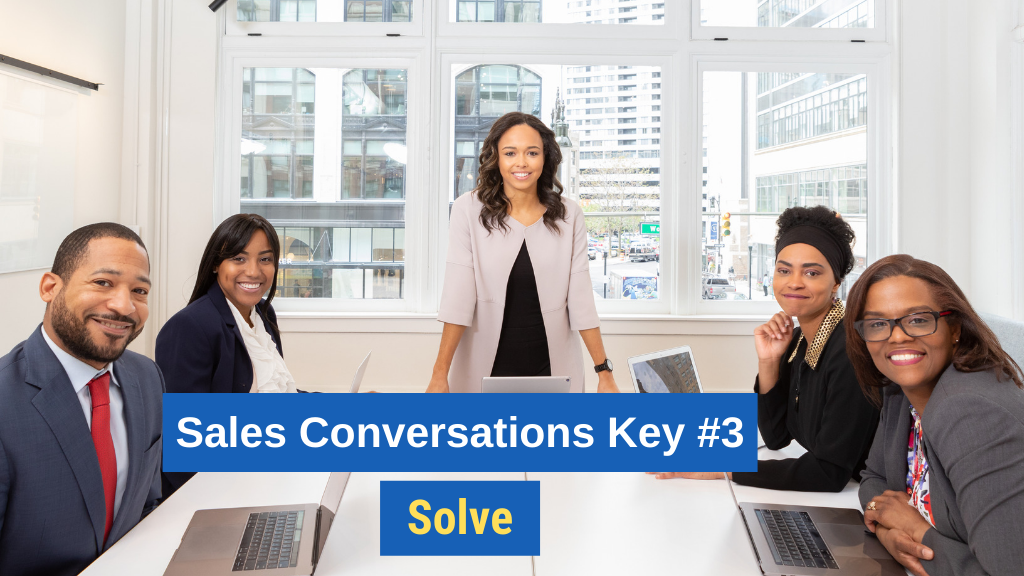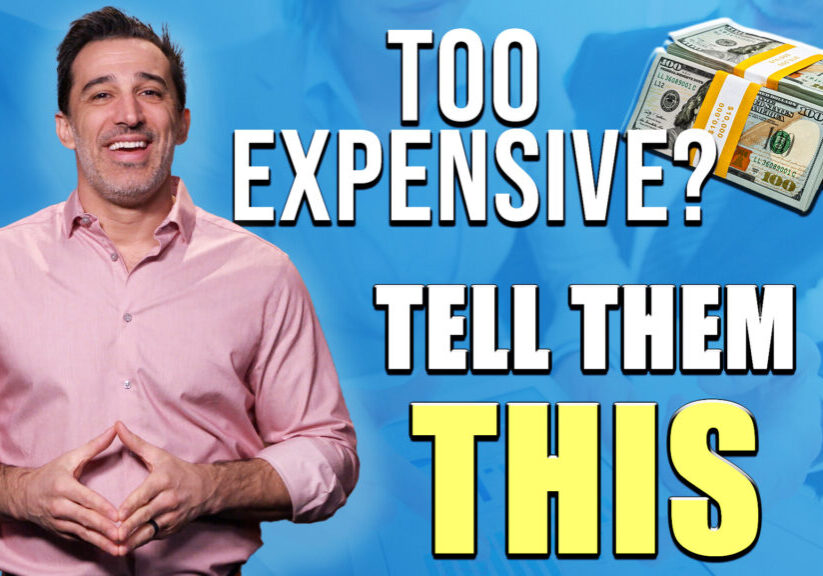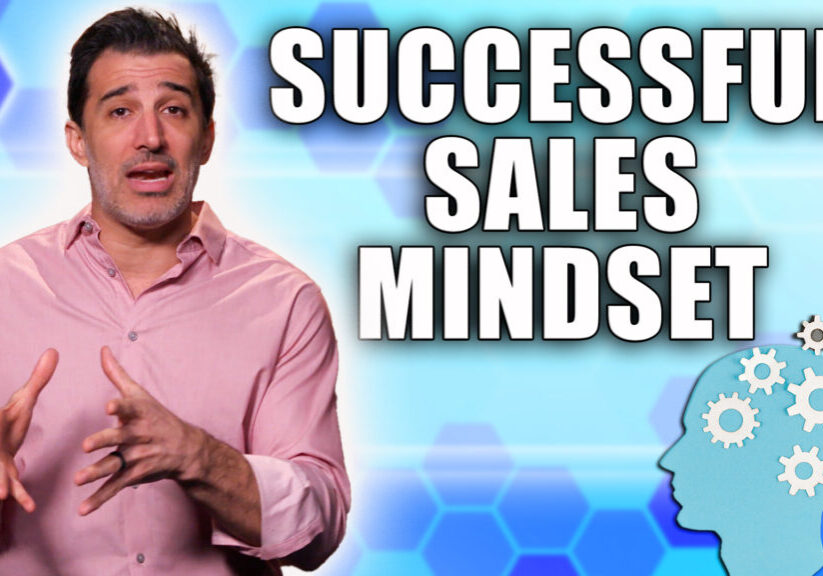How would you like to have better sales conversations that ultimately close more deals?
We all know that sales conversations are at the heart of salespeople’s ability to actually close business. Even so, salespeople today are typically taking one of two incorrect approaches to conversations with prospects.
On one hand, you have salespeople who show up and immediately start pitching, making the conversation all about them.
On the other hand, you have salespeople who jump right in with well-meaning but vague questions such as, “What keeps you up at night?” and “Can I pick your brain about something?”
Neither of these approaches to sales conversations brings any value to the prospect. As a result, buyers are obviously wary of sharing real insight into their world, or telling salespeople about their key challenges.
In this video, I’m going to show you exactly how to overcome these obstacles and get prospects to open up to you during the discovery phase. Here are 3+ keys to sales conversations that close more deals. Check it out:
Video Summary:
Sales Conversations Key #1: Show insight

Showing that you have insight to offer is key to getting prospects talking to you in the first place. As salespeople, we need to establish that we have authority, that we bring value, and that we’re not just going to take time and energy from prospects by asking them tons of questions.
So the first key to successful sales conversations is to give some value by sharing insight at the very beginning. Kick off the conversation with something that’s different than just, “What problems are you facing right now?” Here’s how:
+Opening Play
The first step to sharing insight is to use your Opening Play. This is how you’re actually opening up the sales conversation. Your Opening Play is not the same as your value proposition. Instead, it’s an approach that includes referencing the key challenges you’ve noticed in the prospect’s world. It sounds a little like this: “Right now, I’m seeing a lot of folks in your space dealing with Challenge #1, Challenge #2, and Challenge #3.” This approach helps you get permission to start asking questions, by proving that you already know what’s going on. You’re an expert worth talking to.
+Whiteboard Pitch
Next, you’re going to follow up your Opening Play with your Whiteboard Pitch. Using a piece of paper, a whiteboard, a notepad, or even a napkin, write out some notes about the root causes of the three challenges you mentioned during your Opening Play. What are some of the common issues or problems that cause the challenges? Lay them out for your prospect to see. (If you’re on a virtual Zoom or GoToMeeting, share your screen and use Word or Notepad to do your Whiteboard Pitch.) Finally, include one piece of data or one statistic to back up each “root cause” explanation that you give.
+Engage
Once your whiteboard pitch is done, you simply want to engage the prospect in a conversation about the challenges you’ve just described in detail. Say something like, “Do any of these issues ring true to you?” or “Do you see any of these problems in your world?” Engage them in a conversation that’s totally about them, with the goal of digging deep to understand the challenges they’re currently facing.
Follow these steps for a powerful start to sales conversations that show you have expertise right from the beginning.
Sales Conversations Key #2: Disqualify

Disqualification is a big part of high-quality sales conversations. Most salespeople have been taught to persuade prospects to do business. Disqualification flips that idea on its head.
We don’t need to persuade people to do business with us. Instead, we actually want to disqualify them with a doctor’s mindset: “Is this person really a fit for what I offer? Do I really have the right solutions to solve those particular challenges?”
+Challenges
The first step to disqualification is understanding prospects’ challenges. You’ve shown some insight, and you’ve brought some value—not you want to dig into those key challenges they’re facing in the areas where you can help. Slow down the conversation and let them tell you about some of the key challenges they’re facing at the moment. Nurture the conversation along by asking questions like, “Can you give me an example of that?” or “Help me understand why you say that…”
+Cost
Next, you want to understand the cost of the prospects’ challenges. What’s the upside of solving those challenges? What will it mean to the organization, in dollars, if a solution is found? And what will it cost the organization if a solution isn’t found? We want to understand the actual cost of the challenges that they’ve just told us about. Ask simple questions like, “If you were able to solve this challenge, what would it mean in additional revenue?”
And by the way, if the cost of those challenges isn’t very much, then you know it’s time to eject from the sales conversation. That’s a disqualification moment. You’re done—time to move on to the next one.
+Drive
The final piece of disqualification is to discover what’s driving the prospect. What’s in it for them? One of my mentors used to always say, “Prospects listen to one radio station and one radio station only: WIIFM—What’s in it for me?”
Why do they care about solving these challenges? How does it affect them personally? We want to understand how the challenges are actually hurting them. Ask a question like, “Help me understand why you’re so focused on this issue. How is this challenge affecting you personally?” And now you’re having a sales conversation that they really care about.
If you follow these disqualification steps, you’re going to ultimately avoid so many common sales objections down the road. Why? Because they’ve already told you how important it is to them.
Sales Conversations Key #3: Solve
 In order to have effective sales conversations, you need to show the prospect that you can actually solve their problems. We’ve already shown insight. We’ve disqualified to the point where we know that the prospect is a good fit. Now we’re demonstrating that we can solve their problems. And that’s where a case study presentation comes in.
In order to have effective sales conversations, you need to show the prospect that you can actually solve their problems. We’ve already shown insight. We’ve disqualified to the point where we know that the prospect is a good fit. Now we’re demonstrating that we can solve their problems. And that’s where a case study presentation comes in.
+Case Study Presentation
People are persuaded by stories. If you start to talk about features and benefits, or you try to tell them the solution to their problem, they’re much more likely to resist than if you share a case study or story with actual results. They can’t fight with the facts of a story.
Use case studies, particularly during the early part of your presentations, as a way to demonstrate how your solution will help the organization. This is easy. Simply mention some challenges another client was facing, talk about what was ultimately done to solve those challenges, and then describe the results that were achieved. And by the way, these don’t even have to be written out. Just commit the basics of a few stories to memory and share them as needed in your sales conversations.
+Objections
If you’ve done a good job with your sales conversations up until this point, you’re not going to be getting a lot of objections down the road. The key to handling objections is to avoid them in the first place. Be strong upfront in the disqualification process, and you’re going to have far fewer objections—simple as that. But of course, there’s always still a chance a prospect will give you an objection or two, even if you’ve done a stellar job up until now.
If you hear an objection at this phase of the sales conversation, don’t get into an arm-wrestling match over it. Instead, try to really understand why they’re sharing an objection. Let’s say the prospect tells you that the price is much more than they expected. Don’t start defending your price. Instead, say something like, “I really appreciate your sharing that with me. Help me understand. Why do you say that?”

Clarify exactly what they mean and why they’re objecting, so you can continue the conversation to unpack what they’re actually worried about. Remember, most objections are really just smokescreens for the real problem—and we want to understand what they really care about.
So there you have it. Now you know 3+ keys to sales conversations that close more deals. I want to hear from you. Which of these ideas did you find most useful? Be sure to share your thoughts below in the comments section to join the conversation.
Enjoyed this article? Please share away!

Get instant access to our free sales training:
Why Prospects Push Back on Price, Give 'Think-It-Overs,' and Ghost in Sales Until They Meet a Sales Superstar Who Is Following These 7 Simple Keys

About the Author Marc Wayshak
Marc is is the best-selling author of three books on sales and leadership, including the highly acclaimed titles Game Plan Selling, The High-Velocity Sales Organization and his forthcoming book, Sales Conversations, Mastered.
Marc is a contributor to Inc, HubSpot, Fast Company, Entrepreneur Magazine, and Huffington Post Business. He also hosts a popular YouTube channel on sales strategy with over 103,000 subscribers.
Marc helps thousands of people his data-driven, science-based approach to selling that utilizes all the best tools available to sales organizations today.



![How-to Sell to Power [C-Suite Sales Must-Knows!] How to Sell to Power [C-Suite Sales Must-Knows!]](https://salesinsightslab.com/wp-content/uploads/bb-plugin/cache/How-to-Sell-to-Power-C-Suite-Sales-Must-Knows-1024x576-landscape-7a52c541b28a7b772ad9e1010d8240be-.jpg)


![The Absolute Best Way to Start a Sales Conversation [WITH ANY PROSPECT] The Absolute Best Way to Start a Sales Conversation [WITH ANY PROSPECT]](https://salesinsightslab.com/wp-content/uploads/bb-plugin/cache/The-Absolute-Best-Way-to-Start-a-Sales-Conversation-WITH-ANY-PROSPECT-1024x576-landscape-be9d9379ab94d9f71b5bfeed42246a84-.jpg)